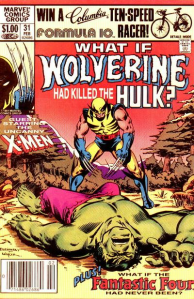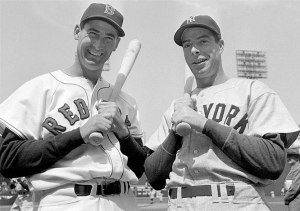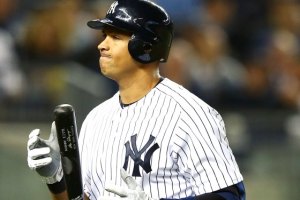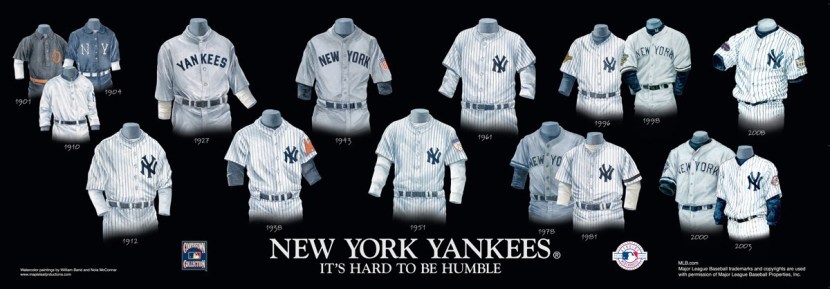Tagged: Jackie Robinson
Alex Rodriguez: What If..?
In Comic Books they are known as ‘What If?’ (Marvel) issues or ‘Elseworld’ (DC) tales, taking the established character out of their established norm and seeing what would have or could have happened if….
A decade later, we revisit called-off engagement between Rodriguez and Boston
From: Gordon Edes
They rank among the great what-might-have-been stories in Red Sox history.
What if an organization with a history of racial intolerance had given more than a sham tryout to Jackie Robinson or listened to the urgings of a scout named George Digby to sign a young outfielder named Willie Mays?

What if Red Sox owner Tom Yawkey had, in the cold light of morning, decided to follow through on the trade arranged over drinks the night before with Yankees co-owner Dan Topping, one in which the Sox would have swapped Ted Williams for Joe DiMaggio? (Note: This deal also was scuttled due to the Yankees reluctance to include a young catching prospect named Yogi Berra.)
And what if the Red Sox had succeeded in their audacious effort 10 years ago to acquire Alex Rodriguez, generally acknowledged as the best player in the game at the time, from the Texas Rangers?
Ten years ago Monday, Rangers owner Tom Hicks declared that effort “totally, totally dead.” He would soon send a letter to Rangers season-ticket holders pledging that Rodriguez would be the team’s shortstop on Opening Day 2004. Then, on Valentine’s Day, he traded him to George Steinbrenner’s Yankees.
With A-Rod now shamed and a shell of his former self, a player who went from being championed by the game’s ruling class to pariah, it is easy to regard Boston’s failed courtship as a blessing, a disaster averted.
But that’s with the benefit of hindsight. At the time, the Sox — and A-Rod — were bitterly disappointed that it did not come to pass, this deal first proposed by Hicks to the Red Sox within days of their crushing Game 7 loss to the New York Yankees in the 2003 ALCS.
 Hicks was looking to get out from under the game’s biggest contract, a $250 million, 10-year deal that in its first three years had not lifted the Rangers out of mediocrity. He asked for Nomar Garciaparra in return. The Sox countered by offering Manny Ramirez, whom they had placed on irrevocable waivers only weeks before without any takers.
Hicks was looking to get out from under the game’s biggest contract, a $250 million, 10-year deal that in its first three years had not lifted the Rangers out of mediocrity. He asked for Nomar Garciaparra in return. The Sox countered by offering Manny Ramirez, whom they had placed on irrevocable waivers only weeks before without any takers.
With that deal in play, Red Sox GM Theo Epstein made another at the winter meetings, arranging to trade Garciaparra to the White Sox for slugging outfielder Magglio Ordonez. That second trade was contingent on the A-Rod deal being approved, but when Epstein entered the hotel room of his new manager, Terry Francona, and rattled off a prospective lineup that included Johnny Damon, A-Rod, David Ortiz and Ordonez, on knees made unsteady by multiple surgeries, Francona climbed onto his bed and did an impromptu dance.
That same night, Epstein slipped out of the meetings in New Orleans and flew to New York to meet with Rodriguez and his then-wife, Cynthia. Owner John W. Henry had already met with the couple in Miami, granted extraordinary permission to do so by commissioner Bud Selig, who had run into Rodriguez at Sammy Sosa’s party in the Dominican Republic and listened to A-Rod earnestly express his desire to play for the Sox.
I was working for the Boston Globe at the time, and I, too, went to Miami to meet with Rodriguez. I liked him. He was smart, engaging and gracious. I believe he really wanted to play for the Sox. I had seen him when he’d made his major-league debut at Fenway as an 18-year-old from Miami, and I was impressed with his appreciation of Boston and what it would mean to his legacy if he would be the one who led the Sox to a World Series title after 86 years without one.
The deal was complicated and ultimately collapsed under its own weight. The Red Sox, for luxury tax reasons, wanted to reduce the value of Rodriguez’s contract by $4 million a year, a total of $28 million over the remaining seven years of his deal. That was a nonstarter for the union. Any reduction, the union lawyers said, would require “added benefits” from the Red Sox — like the Mets gave Mo Vaughn when they added two more teams to the no-trade provisions in his contract in exchange for a $500,000 reduction. The Sox tried to sell the union on an “added benefit” of allowing A-Rod the chance to opt out of his contract after two years and become a free agent, a proposal ridiculed by the union, which argued that A-Rod, because his contract was so much more than anyone else’s, probably would have been looking at a pay cut. They made a counteroffer the Sox deemed unacceptable.
Hicks, meanwhile, was seeking some immediate financial help and not only wanted the Sox to assume A-Rod’s contract, but pay a portion of Ramirez’s deal so that he could pursue some pitching in free agency. That was not going to happen. But on his own, A-Rod contacted Hicks and offered to pay, out of his own pocket, the $15 million Hicks wanted from the Sox. That’s how badly he wanted to come to Boston.
By the end of talks, there were bruised feelings on all sides. Henry was upset that 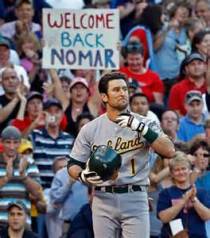 Hicks had made little effort to keep negotiations quiet. Hicks was furious with Sox CEO Larry Lucchino, to the point that Tom Werner became the Sox point man with the Texas owner. Lucchino and union lawyer Gene Orza took whacks at each other. Garciaparra never recovered from the shock of learning that the Sox had sought A-Rod, even as Henry later explained he initially thought that they could have co-existed. And A-Rod resigned himself to remaining with the Rangers.
Hicks had made little effort to keep negotiations quiet. Hicks was furious with Sox CEO Larry Lucchino, to the point that Tom Werner became the Sox point man with the Texas owner. Lucchino and union lawyer Gene Orza took whacks at each other. Garciaparra never recovered from the shock of learning that the Sox had sought A-Rod, even as Henry later explained he initially thought that they could have co-existed. And A-Rod resigned himself to remaining with the Rangers.
The upshot, of course, is that the Sox won two World Series in the next four seasons without A-Rod, and won their third in the 10 seasons in which Rodriguez has been a Yankee. And A-Rod alienated his longtime friend Derek Jeter, the first of many soap operas that would mark his time in New York. And then came the PED revelations.
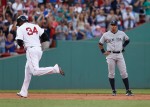 That part of the story, sadly, would have been no different had he played for the Red Sox instead of the Yankees. But the rest of it? Ten years later, I still believe it could have gone a different way for A-Rod in Boston. Instead of a wary Jeter, he would have been embraced by David Ortiz, who remains one of his good friends in the game. He also was very close with Ordonez, who would have combined with A-Rod to more than compensate for the loss of right-handed power Ramirez represented.
That part of the story, sadly, would have been no different had he played for the Red Sox instead of the Yankees. But the rest of it? Ten years later, I still believe it could have gone a different way for A-Rod in Boston. Instead of a wary Jeter, he would have been embraced by David Ortiz, who remains one of his good friends in the game. He also was very close with Ordonez, who would have combined with A-Rod to more than compensate for the loss of right-handed power Ramirez represented.
He would have remained at short, where his value to the club would have been greater than it was to the Yankees at third.
In his first five seasons with the Yankees, through the 2008 season, Rodriguez hit 208 home runs. No one in baseball hit more. And Fenway is much kinder to right-handed hitters than Yankee Stadium. He was one of 10 players who had an on-base percentage greater than .400 in that time. He averaged 6.8 in WAR in that time.
Call me naïve, but I think Boston would have brought out the best in him, and he would have been loved for it.
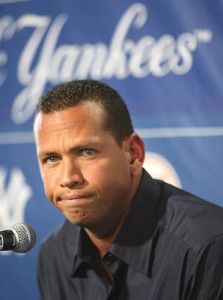 We’ll never know, of course. And in this town, I am well aware, that’s hardly a popular thought. But there’s a part of me that has never forgotten the shining promise of that 18-year-old and laments that it has ended the way it has.
We’ll never know, of course. And in this town, I am well aware, that’s hardly a popular thought. But there’s a part of me that has never forgotten the shining promise of that 18-year-old and laments that it has ended the way it has.
_____
On a personal note: I was at that same game, just a few rows up and sitting between home and the visitors dugout (best seats I ever scored) for that Fenway game where an 18-year-old Alex Rodriguez debuted for Seattle. I sat close enough to see all the awe and wonder on the face of a kid who was walking out into a Cathedral to take his first big league swings. My how times changed as he was on his way to Texas!
Before the PED’s, before the even more inflated ego and sense of entitlement, I was not a fan of the proposed trade. I was a Nomar guy. I didn’t dislike A-Rod at that point, I just disliked the perceived greed and the monster contract and the handcuffs that came with it. How could you as a team hit the free agent market for pitching and additions under those circumstances? Yeesh! Sure the Yankees did it and eventually put a World Series ring on A-Rod’s finger, but we won two in the same amount of time and of course just added the third.
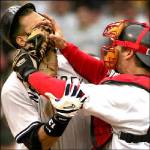 Would or could any of that have happened if we found A-Rod under the tree for Christmas of 2003? Maybe a ring… two at an outside chance? Luckily, this is one of those Scarlett Hose / Bronx Bombers hypotheticals we don’t have to put too much emphasis on… after all, we came out for the better.
Would or could any of that have happened if we found A-Rod under the tree for Christmas of 2003? Maybe a ring… two at an outside chance? Luckily, this is one of those Scarlett Hose / Bronx Bombers hypotheticals we don’t have to put too much emphasis on… after all, we came out for the better.
You know what they say about opinions…
This was posted to Yahoo! Sports on August 31st.
Can’t downplay Saltalamacchia’s postgame dig at Latin players
By Ray Monell, Yahoo! Contributor Network
I must have missed something when I started covering baseball, because apparently excessive celebrating—called hotdogging by traditionalists—is exclusive to players of Latin American descent.
At least that’s what Boston Red Sox catcher Jarrod Saltalamacchia expressed before beat writers Tuesday night following his team’s 5-2 loss to the New York Yankees at Fenway Park.
The catcher was explaining his views of his Yankees counterpart, Francisco Cervelli, who hit a fifth-inning, solo home run off starter John Lackey and clapped his hands (once) as he touched home plate. Lackey took umbrage with the celebration and struck Cervelli in the back with a fastball two innings later. Lackey’s intent was obvious—although he denied it—but the significance of the game for both New York and Boston would be overshadowed by Saltalamacchia’s postgame criticism of Cervelli—and, by extension, more than half of the Western Hemisphere.
“It’s just Latin players,” Saltalamacchia said. “It’s the way they play the game. It’s okay to an extent. If you go a little further than that, that’s when you need to step back.”
I know you were blinded by emotion and indignation, Jarrod, but the only person who went “further than that”—or frankly, too far—was you.
Cervelli, according to his bio, is Italian through his father and Venezuelan on his mother’s side. He was born and raised in Venezuela but has represented Italy in the World Baseball Classic.
Now, let’s switch roles here. Let me put into words what Saltalamacchia said, but from the mouth of a Latin player, just to make painfully clear to those who believe no violation was committed how much of a bigot the catcher came across as.
For instance, imagine Cervelli saying, “It’s just white players. It’s the way they play the game.”
Would he not be singling out a group of people—in a very insulting manner—by saying that?
Again, think for a second, and take the proverbial pull from GM Brian Cashman’s objective pipe, and ask yourself if such a comment from Cervelli—or anyone, for that matter—would meet the qualifications of what deserves to be classified as a racist statement.
Whether Saltalamacchia is an actual racist is something only he and those close to him know, but the words he uttered were indeed racist.
That’s my opinion. What’s yours?
Dear Mr. Monell,
You are an idiot.Do you really mean to tell me, that if Ozzie Guillen had said this, you’d take it the same way? And if this was really another salvo in baseball’s incredibly historic race war, that Ozzie himself, the greastest defender of Latin baseball wouldn’t be rioting to everyone in the radio/television listening world?
Or is this some long-winded inept attempt to take an old world baseball city/team that for decades was looked upon as racist (and with reason thanks to Tom Yawkey’s good ole’ boys club) and just cash in a little more fury. Yes, I’m sure with a name like Saltalamacciha he’s racist to Latinos all the live long day. Just ask David Ortiz… oh wait, Big Papi defended him, right (of course that was during Jarrod’s expanding upon his statement which you chose not to report). Yeah, he must be racist too. Shouldn’t that be your next article of immense importance to the Yahoo! sporting world..? ‘David Ortiz defends racist’
After all, no one has ever accused Latino players of being passionate to the point of sometimes being over-zealous, right? Just like no one has ever taken a quote from a player or manager and used it out of the context for which it was meant.
Salty is racist? That’s a fairly strong accusation in this day and age. However, I’ll hold my judgement till he finds a way to work his white hood in with his RedSox home whites.
Hall of Famer’s who wore Red Sox….
This installment of the investigative process will focus on members of the National Baseball Hall of Fame who have been members of the storied Scarlett Hose, obviously with a bit more focus on those who are enshrined with the ‘B’ on their cap.
members of the storied Scarlett Hose, obviously with a bit more focus on those who are enshrined with the ‘B’ on their cap.
So here is the over all list….
… Players listed in bold are enshrined with the Red Sox ‘B’ upon their cap.
| Player | Years played with the Red Sox |
|---|---|
| Luis Aparicio | 1971-73 |
| Wade Boggs | 1982-92 |
| Lou Boudreau | 1951-52 |
| Jesse Burkett | 1905 |
| Orlando Cepeda | 1973 |
| Jack Chesbro | 1909 |
| Jimmy Collins | 1901-07 |
| Joe Cronin
Andre Dawson |
1935-45
1993-94 |
| Bobby Doerr | 1937-44, 1946-51 |
| Dennis Eckersley | 1978-84, 1998 |
| Rick Ferrell | 1934-37 |
| Carlton Fisk | 1969, 1971-80 |
| Jimmie Foxx | 1936-42 |
| Lefty Grove | 1934-41 |
| Harry Hooper | 1909-20 |
| Waite Hoyt | 1919-20 |
| Fergie Jenkins | 1976-77 |
| George Kell | 1952-54 |
| Heinie Manush | 1936 |
| Juan Marichal | 1974 |
| Herb Pennock | 1915-22 |
| Tony Perez | 1980-82 |
| Jim Rice | 1974-89 |
| Red Ruffing | 1924-30 |
| Babe Ruth | 1914-19 |
| Tom Seaver | 1986 |
| Al Simmons | 1943 |
| Tris Speaker | 1907-15 |
| Dick Williams | 1963-64 |
| Ted Williams | 1939-42, 1946-60 |
| Carl Yastrzemski | 1961-83 |
| Cy Young | 1901-08 |
A few notes: Jimmy Collins does not have a cap in his HOF plaque, however the Hall lists his primary team as Boston. Andre Dawson was omitted from the official Red Sox listing of former Sox in the HOF, however I’m including him because he did in fact play there… I saw it, with my own eyes. Jimmie Foxx is enshrined wearing a Red Sox cap, however the Hall, and rightfully so, recognizes his primary team as the Philadelphia Athletics… the same can be said of Lefty Grove.
And here is the official recording of the retired numbers (excluding Jackie Robinson’s #42 retired by Major League Baseball for the simple fact he was not a member of the Boston Red Sox, even if historically he probably should have been)…
The retired Red Sox numbers, along with Jackie Robinson’s #42 that was retired by Major League Baseball in 1997, are posted on the right field facade in Fenway Park.
The Red Sox policy on retiring uniform numbers is based on the following criteria:
- Election to the National Baseball Hall of Fame
- At least 10 years played with the Red Sox
Bobby Doerr – #1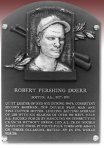
- Played 14 seasons in Majors, all with Red Sox (1937-44, 1946-51), before retiring due to a back injury.
- Elected to Baseball Hall of Fame in 1986.
- Tied for AL lead with Dom DiMaggio in triples in 1950 (11).
- Led AL in slugging percentage in 1944 (.528).
- Named The Sporting News AL Player of the Year in 1944.
- Hit .409 (9-22) in 1946 World Series to lead Red Sox.
Joe Cronin – #4
- First modern-day player to become a league president.
- Elected to Baseball Hall of Fame in 1956.
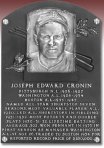
- Compiled .301 average in 20 MLB seasons.
- Affiliated with Red Sox for 24 seasons as player/manager, manager, and general manager.
- Leads all Red Sox managers with 1071 wins.
- Managed Red Sox to AL pennant in 1946.
- Holds AL record for pinch-hit homers in a season, 5 (1943).
- Became 1st player to hit pinch-hit homes in both games of a doubleheader, June 17, 1943 (in a stretch when he hit three three-run pinch-hit homers in four at-bats).
- Participated in 12 All-Star Games for AL, six as a player.
Johnny Pesky – #6
- Signed by the Red Sox in 1940.
- Officially associated with the Red Sox for 21 years as a player, coach, and manager.
- Compiled .307 average in 12 MLB seasons.
- Known as “Mr. Red Sox”.
Carl Yastrzemski – #8
- Named to the Baseball Hall of Fame in 1989.
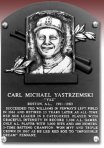
- Along with Johnny Bench became the 18th and 19th players elected to Hall of Fame on the first ballot.
- Received 95 percent of Hall of Fame voting, the seventh highest in the history of voting at that time.
- First Little League player to be elected to the Hall of Fame.
- Won AL Triple Crown in 1967.
- Most games lifetime in the AL with 3,308.
- AL MVP in 1967.
- Seven-time Gold Glove winner.
- Tied MLB record with 1.000 fielding percentage in 1977.
- Selected Outstanding Player of 1970 All-Star Game.
- Played 167 consecutive errorless games.
- Only AL player with 400 home runs and 3,000 hits.
Ted Williams – #9
- Named to starting outfield of Greatest Living Team, 1969.
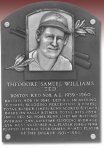
- Named MLB Player of Decade for 1950s.
- Elected to Baseball Hall of Fame in 1966.
- AL MVP in 1946, 49.
- Won AL Triple Crown in 1942, 47.
- Led AL in batting six times.
- Led AL in home runs four times.
- Led AL in total bases five times.
- Led AL in walks eight times.
- Led AL in slugging percentage nine times.
- Holds MLB record for most successive times reaching base safely, 16, in Sept. 1957 (2 singles, 4 HR, 9 BB, 1 HBP).
- Oldest MLB player to win batting title, batting .388 in 1957 at age 39.
- Won batting title again in 1958 at age 40.
- Voted Greatest Red Sox Player of all time by fans, 1969 and 1982.
- Holds MLB rookie records for most walks (107) and RBIs (145).
- Holds Red Sox record with 17 grand slams.
Jim Rice – #14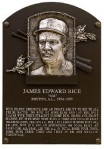
- Debuted August 19, 1974.
- Named AL Silver Slugger in 1984 and 1985.
- Named AL MVP in 1978.
- Named to eight All-Star teams.
- Led AL with hits (213) in 1978.
- Led AL in home runs in 1977 (39), 1978 (46), and 1983 (39).
- Elected to Baseball Hall of Fame in 2009.
Carlton Fisk – #27
- Carlton Fisk will always be remembered as the player who hit the historic, 12th-inning, game-winning homer in
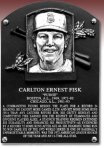 Fenway Park off Reds pitcher Pat Darcy in Game 6 of the 1975 World Series. Besides being the hero on MLB’s biggest stage in a game that has been referred to as “the greatest World Series game ever played,” Fisk had many other memorable highlights during his 11-year career as a member of the Red Sox.
Fenway Park off Reds pitcher Pat Darcy in Game 6 of the 1975 World Series. Besides being the hero on MLB’s biggest stage in a game that has been referred to as “the greatest World Series game ever played,” Fisk had many other memorable highlights during his 11-year career as a member of the Red Sox. - Red Sox first draft choice and fourth overall selection in the January 1967 Winter Baseball Amateur Draft.
- Made his MLB debut on September 18, 1969.
- Was the first unanimous winner of the American League Rookie of the Year Award in 1972 (.293, 22 HR, 61 RBIs). He was also tied for the AL lead with nine triples.
- Won the 1972 AL Gold Glove Award for defensive excellence.
- Seven-time All-Star, including four games started. He was voted as a starter five times but was replaced in 1974 due to a knee injury.
- Was the AL Honorary All-Star Game captain on July 13, 1999 at Fenway Park.
- Is the all-time Red Sox leader in games caught with 990.
- Red Sox Hall of Fame Inductee on September 8, 1997.
Now obviously, Johnny Pesky is the only member of Retired Row who is not a member of the Hall but was retired due to his decades of service to the Olde Towne Team… and rightfully so, however that does leave the ‘door open’ so to speak for other players and a whole sh!tload of “Why not him..”, “He should be..” so on and so forth. And with a few of the omitted Hall of Famer’s not on Retired Row, they may just have a case…. but I’ve covered this very argument in earlier editions of this same blog and this particular entry is not for that reason….
So let’s recap. The Boston Red Sox Hall of Fame. The All-Time Red Sox leaders in statistics. The National Baseball Hall of Fame. Retired Row.
The basics are set.
Ted and Yaz were the only real givens.
Now we get to the difficult part. Who gets added to the list and where do they get placed? Should it be a ‘Top 5’ or a ‘Top 10’? Aside from a minimum number of at bats or appearances, what qualifications should allow for a player to be named ‘Top’ or ‘Best of’ for the Red Sox? Championships are certainly out the door otherwise we’d have to disqualify one of the Greatest Players to Never Win a Title in Williams, and that renders pennants useless as well. If we go just on statistics, it may give an advantage to players who climbed the numbers ladder due to longevity and not superb ability.. but if they didn’t have the ability, one would think they never would have had the longevity.
Rice. Clemens. Evans. The Million Dollar Outfield of Speaker, Hooper and Lewis. Ortiz. Ruth. Vaughn. The Teammates of DiMaggio, Pesky and Doerr. Lynn. Pedroia. Collins. Schilling. Young. Foxx. Tiant. Garciaparra. Varitek. Boggs. Wakefield. Cronin. Grove. Youkilis. Fisk… to name a few.
Decisions, decisions.
A Brief History…
With all this talk of Retired numbers, Honored numbers and such… how about a brief lesson on the history of baseball’s uniforms with a thanks to Wikipedia.
A baseball uniform is a type of uniform worn by baseball players, and by some non-playing personnel, such as field managers and coaches. It is worn to indicate the person’s role in the game and — through the use of logos, colors, and numbers — to identify the teams and their players, managers, and coaches.
The New York Knickerbockers were the first baseball team to use uniforms, taking the field on April 4, 1849, in pants made of blue wool, white flannel shirts (jerseys) and straw hats. The practice of wearing a uniform soon spread, and by 1900, all major league teams had adopted them. By 1882, most uniforms included stockings, which covered the leg from foot to knee, and had different colors that reflected the different baseball positions. In the late 1880s, the Detroit Wolverines and Washington Nationals of the National League and the Brooklyn Bridegrooms of the American Association were the first to wear striped uniforms.
Caps, or other types of headgear with eyeshades, have been a part of baseball uniforms from the beginning. Baseball teams often wore full-brimmed straw hats or no cap at all since there was no official rule regarding headgear. Completing the baseball uniform are cleats and stockings, both of which have also been around for a long time.
By the end of the 19th century, teams began the practice of having two different uniforms, one for when they played at home in their own baseball stadium and a different one for when they played away (on the road) at the other tea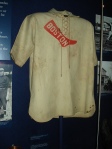 m’s ballpark. It became common to wear white pants with a white color vest at home and gray pants with a gray or solid color vest when away. Most modern teams also have one or more alternate uniforms, usually consisting of the primary or secondary team color on the vest instead of the usual white or gray. Teams on occasion will also wear throwback uniforms.
m’s ballpark. It became common to wear white pants with a white color vest at home and gray pants with a gray or solid color vest when away. Most modern teams also have one or more alternate uniforms, usually consisting of the primary or secondary team color on the vest instead of the usual white or gray. Teams on occasion will also wear throwback uniforms.
Traditionally home uniforms have displayed the team name on the front, while away uniforms have displayed the name of the city (or state) that the team is from. There are many exceptions to that rule, however.
The earliest photographic evidence of the use of uniform numbers comes from a 1909 Chicago Daily News picture of pitching great José Mendez. In the photograph, Mendez is seen in his Cuban Stars uniform with a number “12” on his left sleeve. Inspired by hockey’s and football’s use of uniform numbers, the Cleveland Indians became the first big league club to experiment with numbered uniforms when they took the field at League Park in Cleveland, on June 26, 1916, donning large numerals on their left sleeves. The experiment lasted just a few weeks that season and, after a brief trial the following year, was abandoned altogether.
The first MLB game to have both teams wear numbers on their jerseys was Indians vs Yankees May 13, 1929.
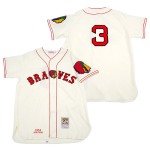 While some players will wear several numbers throughout their careers as they move from team to team, others have become so attached to a specific number for some reason (including superstition), that try to acquire it as they join a new club.
While some players will wear several numbers throughout their careers as they move from team to team, others have become so attached to a specific number for some reason (including superstition), that try to acquire it as they join a new club.
In some cases, the number is available on a player’s new club. Other times, the number will already be in use by another member of that team (or sometimes retired). When this occurs, the player will occasionally ask the other player to change numbers, in order to surrender that number to the newcomer. Some players holding a number in such a case will voluntarily make such a change, while others may need to be “bribed” in order to do so. For example, when Rickey Henderson was traded to the Blue Jays in 1993, he paid new teammate Turner Ward $25,000 for the #24 that Henderson had worn throughout much of his career, and that Ward had been wearing at the time. In contrast, when Mitch Williams joined the Phillies in 1991, he acquired his old #28 from John Kruk in exchange for $10 and two cases of beer.
Some players, who are unable to get the number they had on their previous team, will obtain a number close in succession. For example, Roger Clemens wore #21 during the first 15 years of his career with the Red Sox and Blue Jays, and during his college days at Texas. Upon Clemens’ arrival in New York, he reportedly asked long-time Yankee outfielder Paul O’Neill to surrender his #21, but O’Neill refused. Though he would eventually opt for #22, Clemens initially reversed his beloved #21, and wore #12. Clemens continued to wear #22 upon signing with his hometown Houston Astros in 2004 and, upon resigning with the Yankees, Robinson Canó, owner of #22 at the beginning of the 2007 season, moved to #24 in anticipation of the Yankees possibly re-signing Clemens, leaving #22 available for Clemens.
in succession. For example, Roger Clemens wore #21 during the first 15 years of his career with the Red Sox and Blue Jays, and during his college days at Texas. Upon Clemens’ arrival in New York, he reportedly asked long-time Yankee outfielder Paul O’Neill to surrender his #21, but O’Neill refused. Though he would eventually opt for #22, Clemens initially reversed his beloved #21, and wore #12. Clemens continued to wear #22 upon signing with his hometown Houston Astros in 2004 and, upon resigning with the Yankees, Robinson Canó, owner of #22 at the beginning of the 2007 season, moved to #24 in anticipation of the Yankees possibly re-signing Clemens, leaving #22 available for Clemens.
In their first career games, Cincinnati Reds outfielder Eric Davis and White Sox pitcher Joe Horlen did not have jersey numbers.
Detroit Tigers center fielder Gabe Kapler also played a game with a blank jersey, though it that case the Tigers were playing the final game at Tiger Stadium and the players were honoring the famous Tigers in each position. In Kapler’s case he was honoring Ty Cobb, whose career pre-dated uniform numbers.
 A team will sometimes retire a uniform number so that future players and coaches cannot wear those numbers with that team. Only the player with the retired number can wear that number if he returns to that team as a player or coach. The first Major League Baseball player to have his number retired was Lou Gehrig (#4). #4 and #5 have each been retired by 8 teams, more than any other number. The Yankees have retired a total of 16 numbers, more than any other team. The highest player uniform number to be retired was Carlton Fisk’s #72, but the Cardinals retired #85 in honor of their one-time owner August Busch, Jr.. Though he never wore a unifor
A team will sometimes retire a uniform number so that future players and coaches cannot wear those numbers with that team. Only the player with the retired number can wear that number if he returns to that team as a player or coach. The first Major League Baseball player to have his number retired was Lou Gehrig (#4). #4 and #5 have each been retired by 8 teams, more than any other number. The Yankees have retired a total of 16 numbers, more than any other team. The highest player uniform number to be retired was Carlton Fisk’s #72, but the Cardinals retired #85 in honor of their one-time owner August Busch, Jr.. Though he never wore a unifor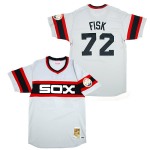 m, that is how old he was at the time of the honor. The Cleveland Indians retired the #455 in 2001 in honor of “the fans”, to commemorate the then-longest home sellout streak ever (although MLB does not allow any team to issue three-digit uniform numbers).
m, that is how old he was at the time of the honor. The Cleveland Indians retired the #455 in 2001 in honor of “the fans”, to commemorate the then-longest home sellout streak ever (although MLB does not allow any team to issue three-digit uniform numbers).
Eight players and one manager, Casey Stengel, have had their numbers retired with more than one team. Nolan Ryan had two different numbers (#30 and #34) retired between three different teams. Fisk’s #27 from the Red Sox and #72 from the White Sox are both retired, as are Reggie Jackson’s #9 and #44, respectively by the A’s and Yankees.
The Toronto Blue Jays do not retire numbers, but rather have an alternative method of honoring their players called the ‘Level of Excellence’.
 In 1997, Major League Baseball, for the first time ever, made a Major League-wide retirement of a number, when #42 could not be issued to any new players, having been retired in honor of Jackie Robinson, although all players who currently wore the number upon the mass retirement of #42, such as Mo Vaughn and Butch Huskey of the Red Sox and Mets, were allowed to keep it under a grandfather clause if they were wearing the number in honor of Jackie Robinson. The only player who still wears #42 is Mariano Rivera of the New York Yankees. The Los Angeles Dodgers, for whom Robinson played (as a Brooklyn Dodger), had already retired the number in 1972 after Robinson’s death.
In 1997, Major League Baseball, for the first time ever, made a Major League-wide retirement of a number, when #42 could not be issued to any new players, having been retired in honor of Jackie Robinson, although all players who currently wore the number upon the mass retirement of #42, such as Mo Vaughn and Butch Huskey of the Red Sox and Mets, were allowed to keep it under a grandfather clause if they were wearing the number in honor of Jackie Robinson. The only player who still wears #42 is Mariano Rivera of the New York Yankees. The Los Angeles Dodgers, for whom Robinson played (as a Brooklyn Dodger), had already retired the number in 1972 after Robinson’s death.
However, the #42 would be worn by a number of players other than Rivera in 2007, which marked the 60th anniversary of Robinson’s first appearance in Major League Baseball (the event that broke the sport’s 20th-century color line). Before the season, then-Cincinnati Reds outfielder Ken Griffey, Jr. asked Robinson’s widow, Rachel Robinson, and MLB Commissioner Bud Selig for permission to wear #42 on April 15, the anniversary date of Robinson’s historic game. Both gave their approval, and Selig later ruled that any player who wished to wear #42 on that date could do so.
Not mine, but important all the same….
This was posted to Yahoo Sports yesterday and it is on a subject I feel is very important to the history of not only ‘The Nation’ but any person who considers themselves a fan of Baseball.
It’s time for the Negro Leagues Museum to move to Cooperstown
 I should start by saying one of the best days I ever spent in Kansas City was at the Negro Leagues Museum.
I should start by saying one of the best days I ever spent in Kansas City was at the Negro Leagues Museum.
It was the day before the 2003 season began and my dad and grandfather were in town to see the White Sox play the Royals on Opening Day. We paid our admissions on that Sunday morning and started looking at the fantastic exhibits full of old uniforms and scorecards. Each case was full of descriptions and stories to pore over and I think I read every word on every card. The thought occurred to me that there weren’t many museums set up better for teaching one subject.
We looked at the amazing statues on the Field of Legends — everyone from Rube Foster to Oscar Charleston — and then watched a short movie featuring Buck O’Neil in the little theater. When we came out, O’Neil himself was standing outside and my grandfather engaged him in a little jabber the way old men often do. They called each other “young man,” patted each other on the back and laughed together. Like thousands of other visitors, we shook hands with Buck, thanked him and left feeling as if the President had shown up to talk with us on a White House tour. We finished our trip by touring the jazz museum next door and taking a short walk down 18th Street for heaping sliced meat sandwiches, unparalleled burnt ends and sweet strawberry soda at Arthur Bryant’s.
It’s a day that remains hard to beat, one I’d recommend to anyone visiting KC.
Yet when I look back at that visit — or any of my four or five other trips — one of the nagging memories is how devoid the museum was of other visitors. I once reported a story on Roger Clemens(notes) taking a tour when the Yankees were in town and the only people in the place were The Rocket, his entourage and O’Neil — who served as a proud tour guide.
And that’s why it comes as no surprise to read yet another story on how the Negro Leagues Museum is in financial trouble and facing an uncertain future. Part of the quagmire is based on a decrease in donations due to the recession, but a lot of the situation is based on the infighting among the museum’s leaders. It’s really quite sad. O’Neil died in 2006, but to see the way some already have forgotten his lessons and legacy suggests he actually passed away many decades ago.

So what to do about the museum — the only one of its kind — before it’s too late? After once being one of its biggest supporters, Joe Posnanski believes the people in charge have “lost their way” and that the place might be “doomed.” Baseball blogger @Wrigleyville23, meanwhile, thinks Major League Baseball should throw a lot of money at the museum to keep it afloat.
I think the solution lies in the middle. Move the museum to Cooperstown, N.Y., where it would have a better chance to flourish.
As Poz’s piece suggests, the methods and motives of the current leadership have started to completely overshadow O’Neil’s original plans for the museum. Its spotlight should shine on the performances of the great black players before the integration of the big leagues and their important place in the struggle for equal civil rights in America. That focus has seemingly disappeared in Kansas City and it seems doubtful that it will return. A fresh start in a new locale is needed.
As for Wrigleyville 23’s plan, I would add that it’s not only MLB’s obligation to keep the memory of the Negro Leagues alive but our obligation as the rest of the baseball world as well. Bringing the museum to Cooperstown would increase foot traffic and donations. More importantly, it would expose more baseball-minded folks to the Negro Leagues beyond the usual fare about Jackie Robinson, Satchel Paige and Cool Papa Bell.
(And I should say here that I envision the museum not being absorbed by the existing Hall of Fame — which already includes Negro Leagues members and associated exhibits — but remaining autonomous in a specially built wing or in its own building. The Negro Leagues deserve more than being turned into a simple sidebar.)
There are undoubtedly any number of logistical problems and challenges that such a move would face, chief among them uprooting the museum from the city that O’Neil and the famous Kansas City Monarchs once called home. The move certainly would rob the museum of a certain local flavor — and I’m not just talking about the post-trip barbecue.
But the simple fact remains that the museum is struggling to draw visitors in a town that’s not exactly a magnet for tourists. So why not move it to the one place where everyone arrives with baseball on the brain? Wouldn’t that be the best way to present the memories that O’Neil worked so hard to preserve?
****
There are several points of comment which I must agree with in addition to the article as a whole.
This is not a ‘color’ issue, but yet it is. As fans, there is no dividing line… our color is the color of the team we root for and the red, white and blue of the MLB. It is partly our responsibility to ensure the history, a very rich one, of the Negro Leagues as part of Baseball’s history and not a sidebar or asterik. But there should also be a greater responsibility on.. well, Negro ball players. Be it African-American, Cuban, Latino… the Negro Leagues weren’t just a ‘dumping ground’ of black players as some ill-minded twits have referred to it (not necessarily here), it was a proving ground of talent and also character for Blacks and Latinos who were denied the opportunity to ply their craft in the ‘major’ leagues. They were denied by, but equal to their white counterparts… as history as easily proven and todays majority of African-American and foreign players need to recognize the sacrifices of those who came before them. Yes, in a way, even Ichiro needs to recognize Buck O’Neil.
So yes, Jimmy Rollins should be opening his checkbook. As should El Tiante (who we all know has a very special and distinct history with the Negro Leagues) Barry f#@&!n’ Bonds, Big Papi, Manny, Pudge Rodriguez, et al,… never mind any responsible white player who believes in the history of his sport. The owners should as well, let’s not forget the fortunes of teams such as the Dodgers and Indians were greatly affected early on in their historic decisions to take on minority players. And perhaps we as fans, the people who literally donate to their paycheck should remind them.
As a member of Red Sox Nation and the long, destructive history of the Yawkey administation’s deep seeded bias against colored people (Remember, we had a shot at Jackie Robinson long before Branch Rickey… and we deep sixed Willie Mays as well) and the talent they represented, I’m a firm believer that we need to fully recognize and support the Negro Leagues as a chapter in Baseball history. Not just MLB, but the evolution of the sport itself.
Should the Negro League Museum be moved to Cooperstown? Abso’freakin’lutely. Will it? Probably not. It is my understanding that the Cooperstown Baseball Hall of Fame and Museum is a private entity working in conjunction with Major League Baseball… therefore an autonomous figure who can ultimately decide it’s own fate free of the MLB administration. Which is why the Negro Leagues are a sidebar to this point in Cooperstown. They have denied the NLM (Negro Leagues Museum) a wing and keep the exhibits to a ‘circulating’ display because there is just ‘so much of it’. Imagine trying to get the NLM as whole in the same building all together.
No, the museum needs to be in Cooperstown, but a free standing exhibit of its own equally celebrated year round and flooded in affection on Induction Day. Just like the Hall itself. Will it happen? Not easily. The folks who run Cooperstown also happen to be the long time city fathers of the town… and have kept growth moderate to suit their desire of keeping Cooperstown a ‘tiny historical hamlet’. Fine by me… we all love those sleepy tourist attractions which offer amazing historical notes. Getting the museum built to their specifications in their decided locale and at their decided price… who knows. In the end, it won’t matter if it is hitorically significant to their own Museum, its still competition. So, I’m sure if we the baseball loving public, former / current players and benefactors pay for it and let them run with a free hand… they may go for it… maybe.
If President Obama, one of the Nation’s biggest sportsfans were involved it sure would help. Hmmm… you know… if Obama, Big Papi, Al Sharpton and Jimmy Rollins showed up on my doorstep with a plan for the NLM, I’d sure as hell listen.
Just sayin’.
